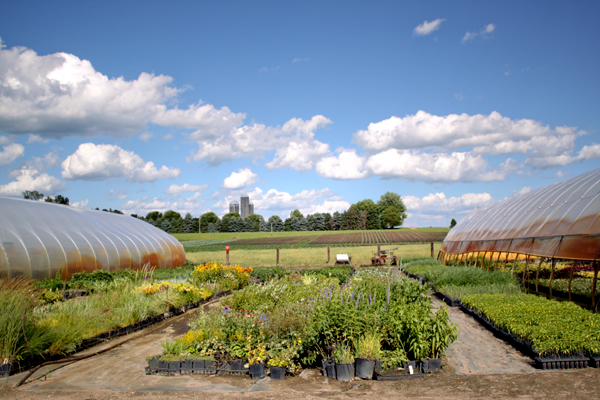
Drive west of the Cities toward Plato, Minnesota, and your eyes will be met with glorious sights: grassy, rolling hills, flat green fields bursting with knee-high-by-the-fourth-of-July corn, and blue skies that run for miles, unmarred by the cloudy haze of urban carbon emissions. These are the spaces from whence we came, the “breadbasket of America,” so to speak. These are the spaces of which we city folk often lose sight as we find ourselves caught in the rat race, the daily grind, the cogs of productivity that keep the metro humming — and they are the spaces with which we might do well to reconnect.
Tour de Farm, a local event organized by Corner Table’s Scott Pampuch, seeks to unite us with these spaces. By experiencing the origins of our food — how animals are raised, how vegetables are grown and harvested — we gain a greater understanding of, and appreciation for, what we consume each day. The monthly event, which caters to about 125 participants for $150 each, features all things farm-fresh and local, from the food and drink consumed to the chef preparing the meal — hence the tagline, “eat, drink, and be farmy.”
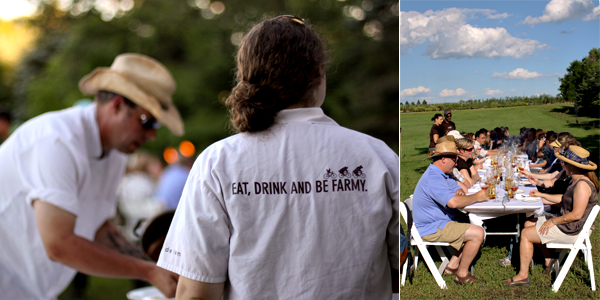
The June 26th event we attended was the first in a six-event series spanning as many months, each held at a different local farm and showcasing the culinary prowess of chefs and restaurants across the city (and, in one notable exception, Duluth). This particular evening featured Tangletown Farms, also known as the supplier to Minneapolis plant and garden store, market, and CSA source Tangletown Gardens. Owners Dean Engelmann and Scott Endres started the farm and gardens concurrently in 2002, about which Dean commented: “We somehow thought a 20- by 100-foot plot would be enough — little did we know how much we would grow!”
The farm and store have grown in popularity so much that Engelmann and Endres established their first CSA this summer, with demand exceeding the 300-share limit they set for the inaugural season. The farm now houses three big greenhouses with plans for a fourth in the works, 24 Scottish Highland cattle, a few large black pigs, a number of Maran and Americana chickens, and three mini donkeys. Each animal figures into Tangletown’s overall philosophy of crop rotation: The cows fertilize the soil, the chickens spread their fertilizer, the pigs act as the ultimate compost — and the donkeys are there for fun.
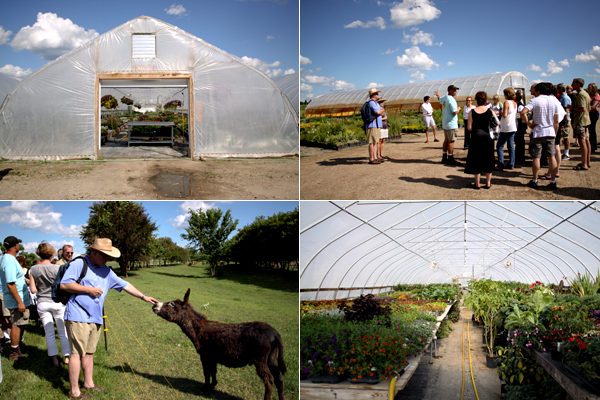
Most evident in Engelmann and Endres’ mission is to provide fresh, quality food. Thus, their garden center is an outlet for more than just annuals and perennials — fresh Tangletown produce and eggs are available daily.
As a testament to this freshness, the vast majority of the ingredients in our dinner that evening were fresh from the farm. Upon returning from a brief tour of the farm, we were invited to partake in a brief social hour featuring the smooth, small-batch 45th Parallel Vodka (from New Richmond, WI), homemade ginger ale, a Spanish white wine, and Fulton’s refreshing strawberry-infused “Lonely Blonde” ale. Small pizzas were served, as was a green garlic terrine — bursting with bright, zippy garlic and just enough salt to highlight the flavors. After a few strains of homey bluegrass, Pampuch led us down the hill to sit down to eat. As he said, “Sundays are supposed to be the day you put down the remote, stop Twittering, and sit down together — so that’s what we do.”

And so the evening began. Throughout the evening, the knowledge we were gaining about the food we ate — where and how it was grown, how and by whom it was prepared, and why we should care — was reinforced by the setting, with cows and chickens in full view in the fields behind us.
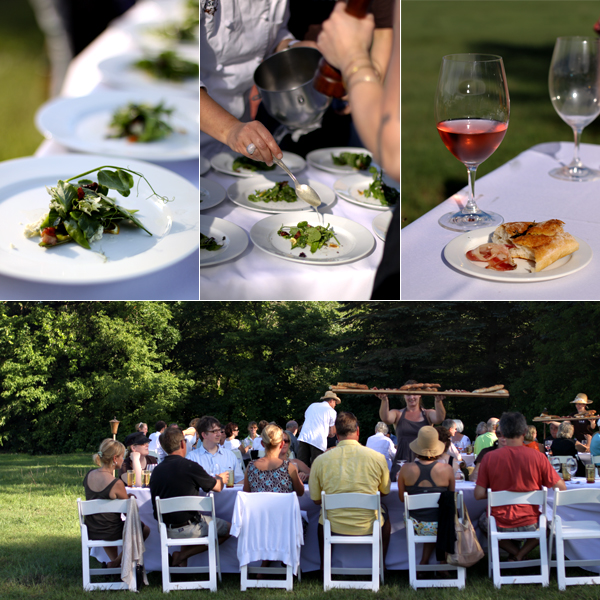
Solo Vino’s Chuck Kanski quickly became the life of the party, his enthusiasm and passion for wine shining through as he and Annette Peters (World Class Wine) introduced the wines of the evening. The first, a dry rosé from the Mediterranean, was paired with a pea tendril salad with vanilla bean vinaigrette. A true ode to the pea, the salad included not only pea shoots, but also snow and sugar snap peas, all of which were picked fresh that morning. Blue cheese from Star Thrower Farm and dried, preserved lemon added a bit of tang and zing, while the warmth of the vanilla bean rounded out the mild vinaigrette. What Michelle Gayer (of the Salty Tart) introduced as “crispy pork business” turned out to be guanciale, made from the same dry-cured Berkshire-Duroc ham as the terrine and the pork loin which would come later. With a baguette, mortadella, and delightful black garlic ciabatta, the course constituted the epitome of fresh, “farmy,” summer eating.
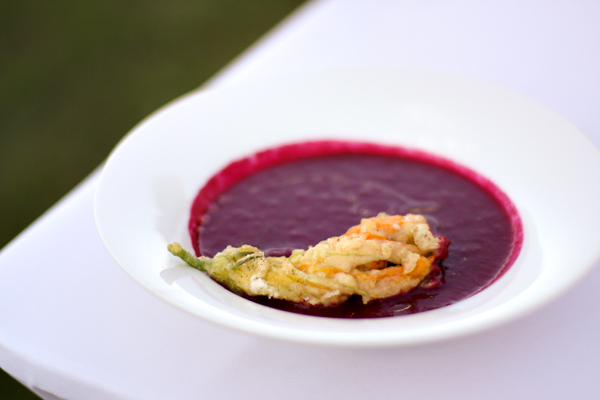
The second course, paired with a 2009 Lioco rosé, was certainly the most innovative. As Pampuch said, “When you think about spring, you think about fresh, really light things” — and Engelmann and Endres had lots of beets, strawberries, and “more zucchinis than God,” so he threw them all together. Upon first taste, the chilled, deep fuschia soup had a mysterious flavor described by many as “bright,” “fermented,” and “carbonated” — the secret ingredient proved to be a splash of Pampuch’s housemade ginger ale. Tempura squash blossoms stuffed with Stickney Hills goat cheese adorned the soup, providing a bit of chew and substance to anchor the dish.
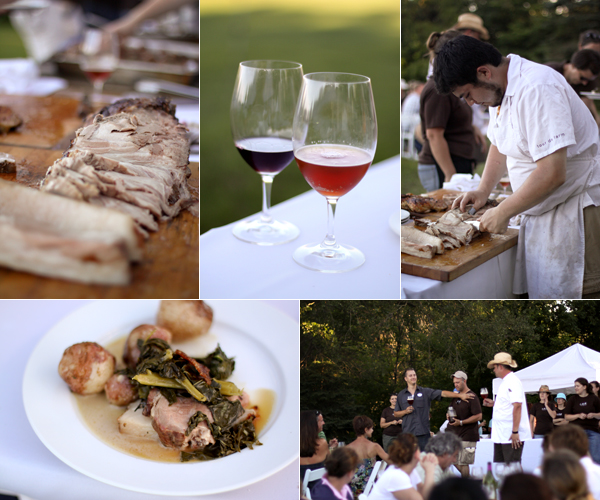
By the third course, we had already consumed the shoulders (mortadella and terrine) and jowls (guanciale) of the three-year old pig; now the loin was unveiled. Served with tender, slow-cooked new potatoes; spring onions à la boulangère; well-seasoned, wilted collard greens; and red Russian kale; the pork had a good, juicy flavor. However, following such delicious and intriguing courses, the otherwise solid pork seemed a bit staid — especially when, for a few guests, one of the two slices of meat was instead a slice of pig fat.
Paired with both a Pena do Lobo Ribeira Sacra red wine and the “beer of the moment” — the Fulton Sweet Child of Vine IPA infused with beet greens (picked fresh that day), the drinks provided a tasty accompaniment and perfect fuel for the drinking game that by now had emerged — as the farm version of the West Wing or State of the Union drinking games, this one required a drink for each mention of something being “picked fresh that day.”

Michelle Gayer, not to be outdone, provided not one, but two, dessert courses.
The first, paired with a crisp, fruity Adami prosecco, comprised strawberries, rhubarb, smoked caramel sauce, goat milk ice cream, a thin, ginger wafer, and Swiss meringue. The work required to produce these components was evident — Gayer put Engelmann and Endres to work whipping Swiss meringue by hand, and she found that making caramel and chocolate close to the smoke and ash from the pig was far tougher than in an industrial kitchen. Nevertheless, the sweet caramel and meringue were the perfect counterpoints to mellow out the tang of the rhubarb, goat milk, and ginger. Any hunger we might have held onto was sated by a Beaujolais rosé paired with Fulton IPA chocolate ice cream with kumquat, cinnamon, cream, and eggs, chocolate nip tuile, caramel and chocolate sauce, and chocolate “dirt” crumbles to symbolically tie even the fanciest of dessert platings back to the earth from whence it came.
The mission on the Tour de Farm site reads, “We believe in Sunday dinners on the farm. We believe in eating vegetables that were picked right outside the kitchen door moments before they are eaten. We believe that we should hear nothing but the sounds of the land and each other at mealtimes. We believe in dirt. We believe in living and eating with the simple harmonies of nature.” By the end of the night, all were stuffed, new acquaintances were made, and a good, “farmy” time was had by all.
Disclosure — Writer and photographer each received a ticket to this event with a face value of $150.
Upcoming events are held on monthly at farms around the state and feature a variety of local chefs. You can check them out at www.tourdefarmmn.com
More photos from Tour de Farm at Tangletown Farm here.
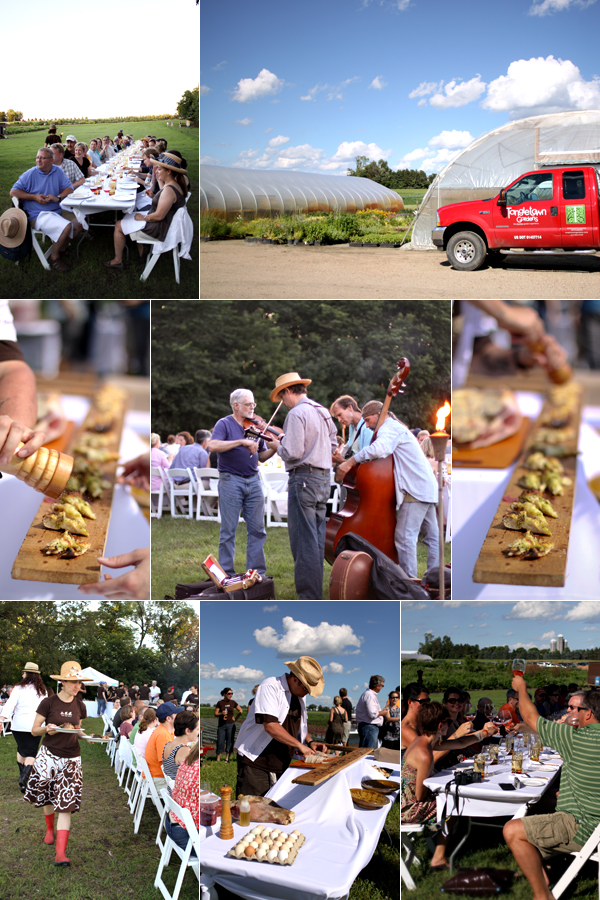

Comments are closed.